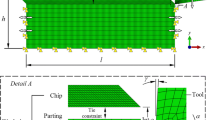Abstract
A Johnson–Cook material model with an energy-based ductile failure criterion is developed in titanium alloy (Ti–6Al–4V) high-speed machining finite element analysis (FEA). Furthermore, a simulation procedure is proposed to simulate different high-speed cutting processes with the same failure parameter (i.e., density of failure energy). With this finite element (FE) model, a series of FEAs for titanium alloy in extremely high-speed machining (HSM) is carried out to compare with experimental results, including chip morphology and cutting force. In addition, the chip morphology and cutting force variation trends under different cutting conditions are also analyzed. Using this FE model, the ductile failure parameter is modified for one time, afterword, the same failure parameter is applied to other conditions with a key modification. The predicted chip morphologies and cutting forces show good agreement with experimental results, proving that this ductile failure criterion is appropriate for titanium alloy in extremely HSM. Moreover, a series of relatively low cutting speed experiments (within the range of HSM) were carried out to further validate the FE model. The predicted chip morphology and cutting forces agree well with the experimental results. Moreover, the plastic flow trend along an adiabatic shear band is also analyzed.
Similar content being viewed by others
References
Ezugwu EO, Wang ZM (1997) Titanium alloys and their machinability—a review. J Mater Process Technol 68:262–274
Molinari A, Musquar C, Sutter G (2002) Adiabatic shear banding in high speed machining of Ti–6Al–4V: experiments and modeling. Int J Plast 18:443–459
Che-Haron CH, Jawaid A (2005) The effect of machining on surface integrity of titanium alloy Ti–6%Al–4%V. J Mater Process Technol 166:188–192
Komanduri R (1982) Some clarifications on the mechanisms of chip formation when machining titanium alloys. Wear 76:15–34
Vyas A, Shaw MC (1999) Mechanics of saw-tooth chip formation in metal cutting. ASME J Manuf Sci Eng 121:163–172
Hua J, Shivpuri R (2004) Prediction of chip morphology and segmentation during the machining of titanium alloys. J Mater Process Technol 150:124–133
Komanduri R, Turkovich BF (1981) New observations on the mechanism of chip formation when machining titanium alloys. Wear 69:179–188
Gente A, Hoffmeister HW (2001) Chip formation in machining Ti6Al4V at extremely cutting speed. Ann CIRP 50:49–52
Komanduri R, Hou ZB (2002) On thermoplastic shear instability in the machining of a titanium alloy (Ti–6Al–4V). Metall Mater Trans A 33 A:2995–3010
Bäker M, Rösler J, Siemers C (2002) A finite element model of high speed metal cutting with adiabatic shearing. Comput Struct 80:495–513
Li L, He N (2006) A FEA study on mechanisms of saw-tooth chip deformation in high speed cutting of Ti–6Al–4V alloy, in: fifth International Conference on High Speed Machining (HSM). Metz, France, pp 759–767
Umbrello D (2008) Finite element simulation of conventional and high speed machining of Ti6Al4V alloy. J Mater Process Technol 196:79–87
Calamaz M, Coupard D, Girot F (2008) A new material model for 2D numerical simulation of serrated chip formation when machining titanium alloy Ti–6Al–4V. Int J Mach Tools Manuf 48:275–288
Barry J, Byrne G, Lennon D (2001) Observations on chip formation and acoustic emission in machining Ti–6Al–4V alloy. Int J Mach Tools Manuf 41:1055–1070
Özel T, Zeren E (2007) Finite element modeling the influence of edge roundness on the stress and temperature fields induced by high-speed machining. Int J Adv Manuf Technol 35:255–267
Liu S (2007) FEM simulation and experiment research of cutting temperature and force in orthogonal cutting of titanium alloys (in Chinese). Dissertation, Nan**g University of Aeronautics and Astronautics, Nan**g
Subbiah S, Melkote SN (2008) Effect of finite edge radius on ductile fracture ahead of the cutting tool edge in micro-cutting of Al2024-T3. Mater Sci Eng A 474:283–300
Subbiah S, Melkote SN (2007) Evidence of ductile tearing ahead of the cutting tool and modeling the energy consumed in material separation in micro-cutting. ASME J Eng Mater Technol 129:321–331
Owen DRJ, Vaz JM (1999) Computational techniques applied to high-speed machining under adiabatic strain localization conditions. Comput Methods Appl Mech Eng 171:445–461
Obikawa T, Usui E (1996) Computational machining of titanium alloy-finite element method and a few results. ASME J Manuf Sci Eng 118:208–215
Sun J, Guo YB (2009) Material flow stress and failure in multiscale machining titanium alloy Ti–6Al–4V. Int J Adv Manuf Technol 41:651–659
Abaqus Inc (2006) Analysis user’s manual. Version 6.6 USA
Ambati R, Yuan H (2010) FEM mesh-dependence in cutting process simulations. Int J Adv Manuf Technol. doi:10.1007/s00170-010-2818-9
Mabrouki T, Girardin F, Asad M, Rigal JF (2008) Numerical and experimental study of dry cutting for an aeronautic aluminium alloy. Int J Mach Tools Manuf 48:1187–1197
Ghadbeigi H, Bradbury SR, Pinna C, Yates JR (2008) Determination of micro-scale plastic strain caused by orthogonal cutting. Int J Mach Tools Manuf 48:228–235
Editorial committee of China Aeronautical Materials Handbook (2001) China aeronautical materials handbook vol.4: titanium alloy & copper alloy, 2nd edn. Stand Press China, Bei**g, pp 104–107, (in Chinese)
Schulz H, Abele E, Sahm A (2001) Material aspects of chip formation in HSC machining. Ann CIRP 50:45–48
Su GS, Liu ZQ (2010) An experimental study on influences of material brittleness on chip morphology. Int J Adv Manuf Technol 51:87–92
Jaffery SI, Mativenga PT (2009) Assessment of the machinability of Ti–6Al–4V alloy using the wear map approach. Int J Adv Manuf Technol 40:687–696
Author information
Authors and Affiliations
Corresponding author
Electronics supplementary material
Below is the link to the electronic supplementary material.
ESM 1
This piece of the submission is being sent via mail. (DOC 26 kb)
Rights and permissions
About this article
Cite this article
Chen, G., Ren, C., Yang, X. et al. Finite element simulation of high-speed machining of titanium alloy (Ti–6Al–4V) based on ductile failure model. Int J Adv Manuf Technol 56, 1027–1038 (2011). https://doi.org/10.1007/s00170-011-3233-6
Received:
Accepted:
Published:
Issue Date:
DOI: https://doi.org/10.1007/s00170-011-3233-6



